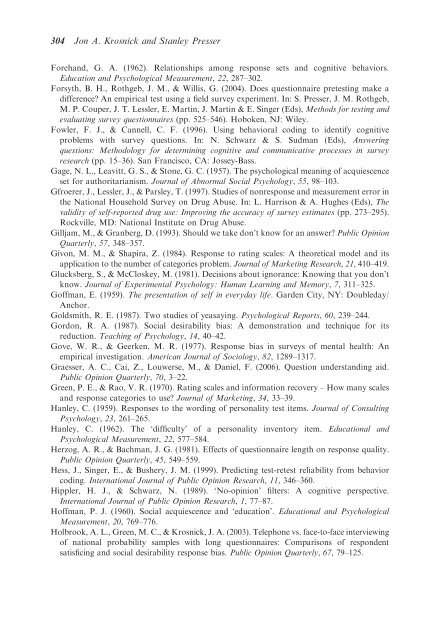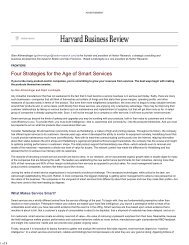Question and Questionnaire Design - Stanford University
Question and Questionnaire Design - Stanford University
Question and Questionnaire Design - Stanford University
You also want an ePaper? Increase the reach of your titles
YUMPU automatically turns print PDFs into web optimized ePapers that Google loves.
304 Jon A. Krosnick <strong>and</strong> Stanley PresserForeh<strong>and</strong>, G. A. (1962). Relationships among response sets <strong>and</strong> cognitive behaviors.Education <strong>and</strong> Psychological Measurement, 22, 287–302.Forsyth, B. H., Rothgeb, J. M., & Willis, G. (2004). Does questionnaire pretesting make adifference? An empirical test using a field survey experiment. In: S. Presser, J. M. Rothgeb,M. P. Couper, J. T. Lessler, E. Martin, J. Martin & E. Singer (Eds), Methods for testing <strong>and</strong>evaluating survey questionnaires (pp. 525–546). Hoboken, NJ: Wiley.Fowler, F. J., & Cannell, C. F. (1996). Using behavioral coding to identify cognitiveproblems with survey questions. In: N. Schwarz & S. Sudman (Eds), Answeringquestions: Methodology for determining cognitive <strong>and</strong> communicative processes in surveyresearch (pp. 15–36). San Francisco, CA: Jossey-Bass.Gage, N. L., Leavitt, G. S., & Stone, G. C. (1957). The psychological meaning of acquiescenceset for authoritarianism. Journal of Abnormal Social Psychology, 55, 98–103.Gfroerer, J., Lessler, J., & Parsley, T. (1997). Studies of nonresponse <strong>and</strong> measurement error inthe National Household Survey on Drug Abuse. In: L. Harrison & A. Hughes (Eds), Thevalidity of self-reported drug use: Improving the accuracy of survey estimates (pp. 273–295).Rockville, MD: National Institute on Drug Abuse.Gilljam, M., & Granberg, D. (1993). Should we take don’t know for an answer? Public OpinionQuarterly, 57, 348–357.Givon, M. M., & Shapira, Z. (1984). Response to rating scales: A theoretical model <strong>and</strong> itsapplication to the number of categories problem. Journal of Marketing Research, 21, 410–419.Glucksberg, S., & McCloskey, M. (1981). Decisions about ignorance: Knowing that you don’tknow. Journal of Experimental Psychology: Human Learning <strong>and</strong> Memory, 7, 311–325.Goffman, E. (1959). The presentation of self in everyday life. Garden City, NY: Doubleday/Anchor.Goldsmith, R. E. (1987). Two studies of yeasaying. Psychological Reports, 60, 239–244.Gordon, R. A. (1987). Social desirability bias: A demonstration <strong>and</strong> technique for itsreduction. Teaching of Psychology, 14, 40–42.Gove, W. R., & Geerken, M. R. (1977). Response bias in surveys of mental health: Anempirical investigation. American Journal of Sociology, 82, 1289–1317.Graesser, A. C., Cai, Z., Louwerse, M., & Daniel, F. (2006). <strong>Question</strong> underst<strong>and</strong>ing aid.Public Opinion Quarterly, 70, 3–22.Green, P. E., & Rao, V. R. (1970). Rating scales <strong>and</strong> information recovery – How many scales<strong>and</strong> response categories to use? Journal of Marketing, 34, 33–39.Hanley, C. (1959). Responses to the wording of personality test items. Journal of ConsultingPsychology, 23, 261–265.Hanley, C. (1962). The ‘difficulty’ of a personality inventory item. Educational <strong>and</strong>Psychological Measurement, 22, 577–584.Herzog, A. R., & Bachman, J. G. (1981). Effects of questionnaire length on response quality.Public Opinion Quarterly, 45, 549–559.Hess, J., Singer, E., & Bushery, J. M. (1999). Predicting test-retest reliability from behaviorcoding. International Journal of Public Opinion Research, 11, 346–360.Hippler, H. J., & Schwarz, N. (1989). ‘No-opinion’ filters: A cognitive perspective.International Journal of Public Opinion Research, 1, 77–87.Hoffman, P. J. (1960). Social acquiescence <strong>and</strong> ‘education’. Educational <strong>and</strong> PsychologicalMeasurement, 20, 769–776.Holbrook, A. L., Green, M. C., & Krosnick, J. A. (2003). Telephone vs. face-to-face interviewingof national probability samples with long questionnaires: Comparisons of respondentsatisficing <strong>and</strong> social desirability response bias. Public Opinion Quarterly, 67, 79–125.
















